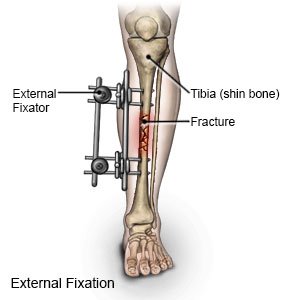External Fixation Device for a Child
Medically reviewed by Drugs.com. Last updated on Aug 4, 2025.
What do I need to know about an external fixation device?
An external fixation device has a metal frame. The frame may go around the limb (arm or leg) or it may go along one side of the limb. The frame is held in place by pins and wires. The pins and wires are put through the skin and attach to bone. The device is used when your child has a complex break or a bone deformity. The device is put in place during surgery.
 |
What do I need to know about site care?
Site care while your child has the device in place is important. Pin sites are where the pins or wires enter the skin. Germs can get into your child's body through the pin sites and cause infection. Care includes cleaning the sites and looking for infection. Your child's healthcare provider will teach you and your child how to clean the sites. He or she will tell you how many times in a day to do the cleaning and check for infection.
How do I clean my child's pin sites?
Follow the specific instructions from your child's healthcare provider.
- You may need to use gauze, cotton swabs, tweezers, a squirt bottle, or gloves. Use a different gauze and swab for each site.
- Your healthcare provider will tell you which liquid to use to clean the site. He or she may tell you to use peroxide, saline, or soap and water.
- You can soak gauze in the liquid and wrap it around the pins to help remove any crusting.
- Always wash your hands before and after you clean the sites.

How do I keep my child comfortable?
- Elevate your child's arm or leg above the level of his or her heart as often as you can. This will help decrease swelling and pain. Prop your child's limb on pillows or blankets to keep it elevated comfortably.

- Apply ice on your child's limb for 15 minutes every hour or as directed. Use an ice pack, or put crushed ice in a plastic bag. Cover it with a towel before you apply it to your child's skin. Ice helps to decrease swelling and pain.
When should I call my child's doctor?
- Your child has a fever of 100.4°F (38ºC) or higher.
- Your child's fingers or toes look pale or blue, and are cold, numb, or tingling.
- Your child has pain and warmth at the pin sites.
- Your child's sites have more redness and drainage than usual.
- The frame or pins are loose or move more than usual.
- You have questions or concerns about your child's condition, care, or device.
Care Agreement
You have the right to help plan your child's care. Learn about your child's health condition and how it may be treated. Discuss treatment options with your child's healthcare providers to decide what care you want for your child. The above information is an educational aid only. It is not intended as medical advice for individual conditions or treatments. Talk to your doctor, nurse or pharmacist before following any medical regimen to see if it is safe and effective for you.© Copyright Merative 2025 Information is for End User's use only and may not be sold, redistributed or otherwise used for commercial purposes.
Further information
Always consult your healthcare provider to ensure the information displayed on this page applies to your personal circumstances.
